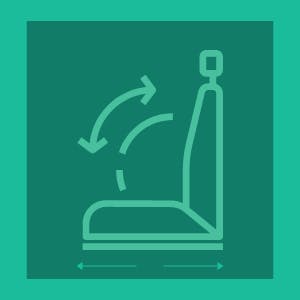
Once you've adjusted your car to better suit you, you'll be able to focus all of your attention on the road ahead. This time, we're looking at setting up your car steering wheel. If you don't take the time to adjust it properly, it could lead to issues with your posture and, more importantly, your ability to drive safely.
In this guide, we're going to go through all of the steps involved in setting up your car steering wheel.
Setting up your car steering wheel
To adjust your steering wheel, you will only need to use one manual control. Under the steering column (right below the wheel), you'll notice a small lever that lies flat against the column. As we'll discuss further below, you can pull this lever to adjust the height and depth of your steering wheel.

Adjust your seat
- Before you can even think about sorting out your steering wheel, you've first got to adjust your car seat. If you don't, you could end up with a steering wheel that's too close to you and pedals that are too far away.
- Use the lever/button on the side of your seat to adjust the height so that you can see the road ahead and behind. You can then alter the angle of the seat using a dial/button at the side.
- Finish off by adjusting the position of the car seat, using a bar/lever at the bottom of the seat. You'll need to be able reach and depress the foot pedals without having to move forward in your seat.

Position yourself and prepare
- We're one step closer to adjusting your steering wheel! All that's left for you to do is to sort out your position. (If you don't sort this out, your steering wheel adjustments won't be correct.)
- Sit right back in your car seat with your shoulders resting against the backrest. You shouldn't be scooting forwards to reach the pedals or the steering wheel.
- Next, place your hands on the steering wheel at 9 o'clock and 3 o'clock (or 10 o'clock and 2 o'clock). If your arms have to stretch too far, you know that you'll need to make serious adjustments to the depth of the wheel.
- Similarly, if you find that you have to hold your arms up too high or low to grasp the wheel, you'll need to make serious adjustments to the height of the wheel.

Adjust the depth of the steering wheel
- Your steering wheel needs to be positioned so that when you're sat fully back, your hands can rest on top of it. Once you move your hands to the correct positions on the wheel, your arms should be slightly bent.
- To adjust the depth, you should look below the wheel to the steering column and pull the lever you find. Once the lever is down, you'll be able to make your adjustments.
- Keep your hands on the steering wheel and then push, or pull, to change the depth. If the wheel is too close to you, push it further away. If it's not close enough, then pull it towards you.
- Once you think you're happy with the position, you can either push the lever back so that you can sit back and truly determine if the depth is correct, or leave it and move onto adjusting the height below.

Adjust the height of the steering wheel
- It's important that you adjust the height of your steering wheel to match both your height and posture. You don't want to be tensing your shoulders and arms as you drive because the steering wheel is too high or low.
- If you've put the lever back in place, pull it once more to adjust the height of the steering wheel. It needs to be pointed towards your chest (around 10 inches away), not your head. This will ensure that in the event of a collision, the airbag will provide you with maximum protection and reduce the risk of injury.
- As you adjust the height, make sure that you can still see all of the warning lights and instrument gauges on the panel in front of you. If the steering wheel is blocking them, you'll need to move it up or down.
- Once you're done, push the lever back up so that it rests flat against the column. Make sure that it's securely in place by trying to move the wheel up and down.
Testing it out
Sometimes, there's no way of knowing whether or not adjustments are spot on until you actually start driving. It might seem perfect whilst you're sat still, but once you start physically steering, it might be another story entirely.
If you do realise that the steering wheel is too close/far away, or too high/low, it's important that you do not adjust it while you're still moving. Doing so could result in you losing control of the car and crashing. If it's bothering you that much, pull over in a safe place and adjust it once you've stopped the car.
As you're driving, make sure that you're holding your steering wheel correctly. This will ensure that you maintain control of the vehicle, and also stop the airbag from inflicting serious injury in the event of a collision. (If you're holding it incorrectly, e.g., both hands at 12 o'clock, the triggered airbag could cause serious damage to your arms.)
Additional resources
Video tutorial
Still a bit confused about setting up your car steering wheel? Not to worry! If you'd prefer to see how the process works in real life, you can get the full lowdown in the video tutorial below.
This quick two minute clip will walk you through setting up your car steering wheel and also talk about what you need to know when you go through the process.
FAQs
1. What position should my hands be on the steering?
There are two steering wheel hand positions that you should be aware of:
- 10 and 2: place your left hand at 10 o'clock on the wheel and your right hand at 2 o'clock. This is the position favoured by most driving instructors.
- 9 and 3: place your left hand at 9 o'clock on the wheel and your right hand at 3 o'clock. This is a slightly more relaxed position.
It doesn't matter which of these two hand positions that you pick. As long as it's comfortable for you, that's all that matters.
2. How close should I be to the steering wheel?
Ideally, you should be around 10 inches away from the steering wheel. This means that if the airbag is triggered in a collision, the impact won't cause you serious harm.
3. Can I adjust my steering wheel as I'm driving?
No! Under no circumstance should you ever try to adjust your steering wheel as you drive. You could end up losing control of the car and hurt not only yourself, but others around you.
4. How do I know if my steering wheel is properly adjusted?
You'll know if the steering wheel is in the incorrect position if it's causing you a lot of tension in your shoulders and arms. If it's clearly uncomfortable for you, then it's clear that you need to make adjustments.
5. Will I learn how to set up a car steering wheel in my driving lessons?
Yes! In your first driving lesson, your driving instructor will start off by introducing you to the cockpit drill. This is a process in which you will check that the car is properly adjusted to suit you. You'll be shown how to set up your car seat, steering wheel, seatbelt, headrest, mirrors and much more.
Subscribe for driving advice, offers & more
We'd love to let you know about our courses, news and offers via email. You may unsubscribe at any time.
Star Genie Limited trading as PassMeFast. Company number 10093359
Copyright © 2024 owned by Star Genie Limited
PassMeFast, Blue Tower, MediaCityUK, Salford, M50 2ST
